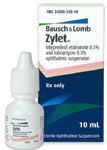Article
Combination drug provides dual corticosteroid/antibiotic therapy
The recently approved fixed combination of loteprednol etabonate 0.5%/tobramycin 0.3% (Zylet, Bausch & Lomb) is the first combination corticosteroid/ anti-infective ophthalmic product to be introduced to the market in more than 15 years.

The drug's availability is welcome news for ophthalmologists and other health-care providers who prescribe medications for management of steroid-responsive inflammatory ocular conditions accompanied by the presence or a risk of superficial ocular bacterial infection, said Charles B. Slonim, MD.
"This combination product affords the time-tested efficacy of both loteprednol and tobramycin, but with the unparalleled safety of corticosteroid treatment with loteprednol," said Dr. Slonim, a private practitioner in Tampa and affiliate professor of ophthalmology, University of South Florida, Tampa.
The indications for ocular steroid use include allergic conjunctivitis and blepharitis, acne rosacea, superficial punctate keratitis, herpes zoster keratitis, iritis, and cyclitis, he added.

Prior to FDA approval, Zylet was investigated in a bioavailability study and a 42-day placebo-controlled safety study. The bioavailability study confirmed ocular penetration of loteprednol etabonate was not decreased when it was administered together with tobramycin in a fixed combination product. Likewise, the antimicrobial activity of tobramycin was not diminished when administered in a fixed combination with loteprednol. The safety trial showed increased IOP developed in 10% of Zylet-treated subjects (mean 1.6 mm Hg) and 4% of controls (mean 1.1 mm Hg).
Dr. Slonim observed that previous clinical studies have documented the efficacy and safety of loteprednol for controlling inflammation postcataract surgery and in eyes with anterior acute uveitis or giant papillary conjunctivitis (GPC). In addition, it has been shown effective for managing seasonal allergic conjunctivitis and for reducing inflammation after trabeculectomy and in association with keratoconjunctivitis sicca.

Newsletter
Don’t miss out—get Ophthalmology Times updates on the latest clinical advancements and expert interviews, straight to your inbox.





